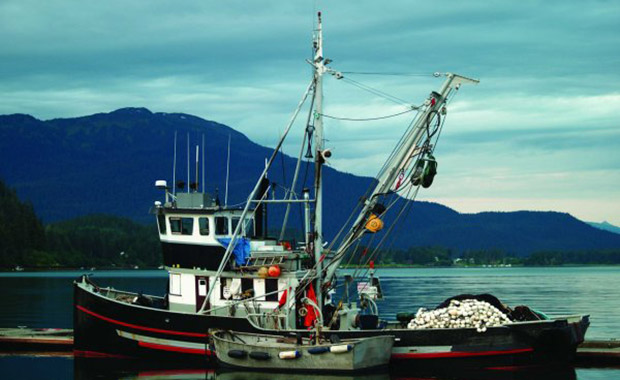
Consumers, though, are hardly aware of these changes — because nowadays it is a smaller number of more powerful, modern vessels, with crews of two or three, that bring fish to local ports, though in smaller quantities than those that trawled the North Atlantic over a century ago. Meanwhile, larger, immensely more powerful vessels range farther afield in the richer fishing grounds off West Africa, South America and in the Pacific.
Most seafood served in Europe and North America comes from the waters of the global South, whose small-scale fishermen cannot compete with the industrial fleets seeking what they can no longer catch, or are not permitted to catch, in northern waters. Though Western governments, particularly the United States, are working to conserve and replenish their fishing grounds, the worldwide depletion of fish stocks continues apace.
We are trying slowly to repair the mess we’ve made of our Northern fisheries, but we are doing this by transferring the problem, trying to solve overfishing in one place while worsening the problem somewhere else.
Both the United States and the European Union import 70 percent of their seafood. Most of it comes from the 200-mile Exclusive Economic Zones of West and East African countries, and from island countries in the Central and South Pacific, where European fleets operate in competition with fleets from East Asia, notably China. Some of this fishing is illegal, but much is done under legal “partnership agreements” with local governments. These countries get a fraction of the value for the use of their offshore resources, while the scale of the catches puts their food security at risk.
The United Nations Food and Agriculture Organization reports that the size of the annual world catch since the 1990s is either stagnating or slowly declining, at great cost to society and to marine ecosystems. This trend is undercutting recent progress. Fishing grounds off the United States are being replenished, owing to the passage in 1976 of the Magnuson-Stevens Act, which took aim at the twin scourges of overcapacity fueled by government subsidies to the American fishing fleet, and the subsequent overfishing of depressed stocks. Meanwhile, the European Parliament, under pressure from consumers, environmental organizations and maritime scientists, adopted a series of measures last year that could, if implemented, have similar positive results. These include:
•Enforcing new catch limits so that fish population levels should, by 2020, recover, enough to generate the “maximum sustainable yield” called for under the United Nations Convention on the Law of the Sea.
•Phasing out the discarding at sea of unwanted fish, which often involves half or more of the catch of edible fish. This is a huge problem, since discarded fish are not recorded, and thus not taken into account when setting quotas.
•Protecting biodiversity by incorporating local stakeholders into the management of ecosystems.
•Paying greater attention to monitoring the huge European fleets operating in the waters of developing countries.
These proposals can still be blocked or undermined. Industry lobbies and the threat of lost jobs have prevented a reduction of the government subsidies — loan guarantees for purchasing new engines, electronic fish-finders and other technologies — that contribute so much to overcapacity. Powerful forces, like the Comité National des Pêches Maritimes, argue that implementing the stock-rebuilding mandate, phasing out the practice of discarding, and other measures would ruin the industry.
Such arguments can be politically effective; similar arguments, emanating from the same French industry group and its allies have prevented a ban of the destructive practice of deep-sea trawling from being voted into European law.
More than 20 years ago, Norway, which is not a European Union member, banned discarding and imposed restrictions on herring and cod, demonstrating — as the United States is doing now — that when left unfished, or lightly fished, stocks recover within 5 to 10 years.
We urgently need to rebuild stocks in developed countries, and to lessen their dependence on imports from the developing world. With less competition from the subsidized distant-water fleets, the maritime countries of the developing world could then exploit the fish in their own waters with their own fleets, rebuild their fish stocks as well and supply their own markets.
Meanwhile, we have to protect the fisheries of the global South. The maritime countries of Africa and the small Pacific island states have no industrial fisheries; the few industrial vessels that carry their flags are often “joint ventures,” with only nominal links to the host country. Foreign fleets compete with local fishermen, who usually supply local markets. But these so-called small-scale local fisheries nevertheless contribute one-third to one-half of the catch in most developing countries.
Their role is widely underestimated, notably because the developing countries that are members of the United Nations Food and Agriculture Organization usually omit small-scale fisheries in their annual reports. As a result, the organization’s world catch estimates are far too low.
We must not accept the mantra that we can’t afford to protect fish stocks because of growing demand for seafood. When stocks are already strongly exploited, fishing more means less fish can be caught, not more. Rather, we should follow the example of the developed countries that have managed their fisheries so that stocks can replenish themselves. With careful and determined steps, developing nations can ensure high, sustained catches — meeting not only their own needs but supplying world markets as well.
Daniel Pauly is a professor of fisheries at the Fisheries Center of the University of British Columbia in Vancouver.



